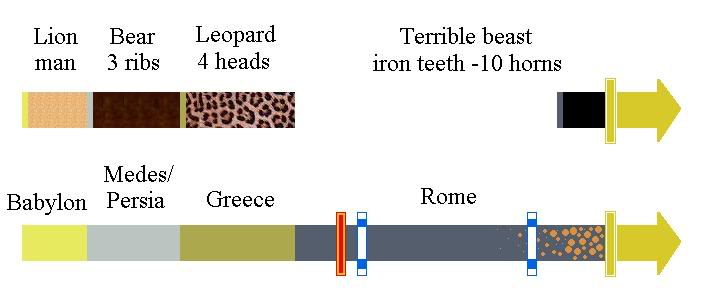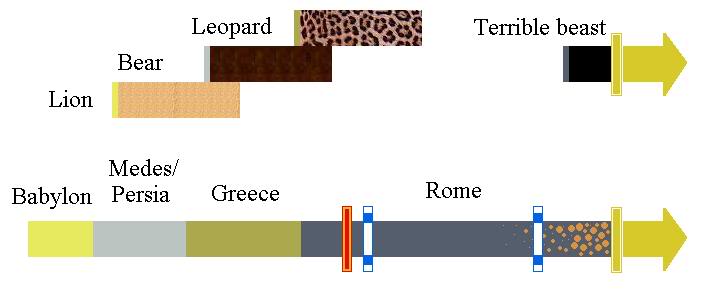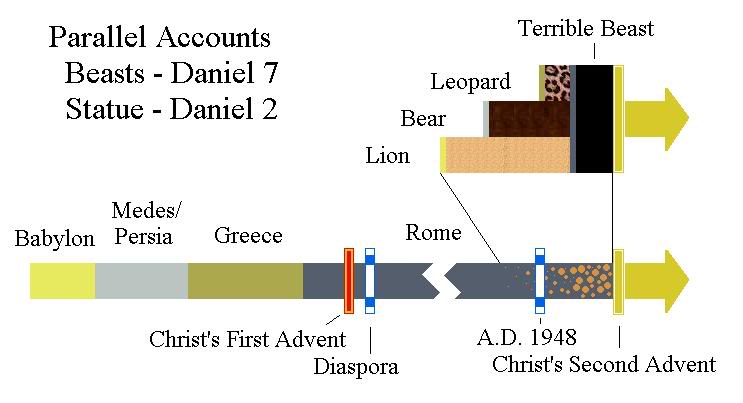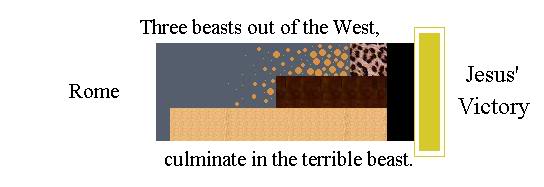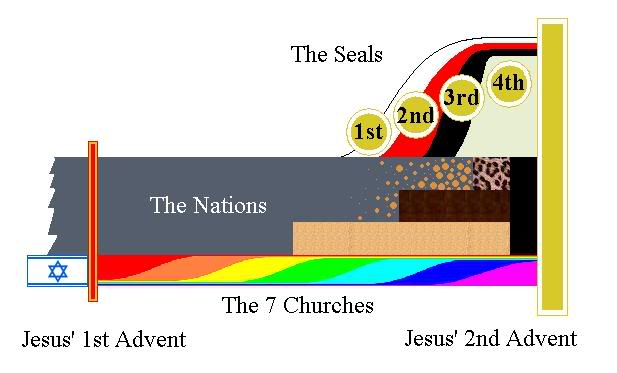The Four Beasts
The history of how Daniel chapter 7 has been interpreted as being analogous on a 1:1 basis to Daniel chapter 2 is important in understanding how an error from the past can propagate to today. Scholars have long poured over Daniel’s vision of the beasts in chapter seven and compared them to the four kingdoms of Nebuchadnezzar’s statue. The linkage between the visions of Nebuchadnezzar’s statue with Daniel’s beasts includes that both were written in Aramaic: true. The book of Daniel has an overall symmetrical construction to it, and likening chapter 7 to chapter 2 is substantiated on that basis: true. Another is the coincidence that both are four in number: true. It is not surprising that commentaries and study Bibles will draw a one for one connection between the parts of the statue and the beasts. However, the comparison between the two does not fit exactly; they do not align in every aspect. Two verses given in Daniel 7 conflict with the information given in Daniel chapter 2 which invalidates a complete 1:1 equation between the two chapters.
Historically, the parts Daniel names before in chapter two are only ones scholars had to look at to assign their meaning. This comes to mind if the beasts of chapter 7 are end time nations; commentators preceding them would have nothing to look at so as to discern their true nature. The impossibility lies with their being able to predict the type of nations these beasts might be from their descriptions before these nations have developed – were they future to their examination. Only by looking back and finding characteristics for comparison can one see how the prophecy has been fulfilled.
So if these beasts were to represent end time nations, any commentary before these nations took shape and became recognizable would excuse those commentators from being able to predict the beasts of chapter seven. As they are revered, and once a die is cast it is not easily departed from by following commentators; reluctance to go against what has been long established is quite understandable. And after so much has been written, the prevailing misapplication becomes an accepted fact and the matter has been judged settled, no one looks for any other possible solution that fits better. But getting back to the fact that the comparison is invalidated within the text of Daniel chapter 7, should allow for a reexamination for the majority view of parity between the statue and the beasts.
To show the beasts from a different aspect, this section will challenge the absolute one-for-one comparison between the statue and the beasts. That comparison leads to the beasts and the statue to be only considered as multiple accounts of the same timeline.
As way of explanation for the following diagram, the top line represents Daniel 7. The vertical gold bar represents Jesus’ coming anew at the end of man’s reign; establishing the Millennium Kingdom of His Reign. The bottom timeline represents Daniel 2. The vertical gold and red bar represents Jesus’ First Advent Ministry. The first vertical blue and white bar represents Israel’s demise as a nation after the second Jewish Revolt in the second century A.D., while the second vertical blue and white bar represents the formation of the modern state of Israel post-WWII. The vertical gold bar at the end of chapter 2 is the same as it is in the first case: the Return of Jesus and the establishment of His Millennium Kingdom. This information was conveyed previously in my book, so I have inserted this paragraph here for you the reader.
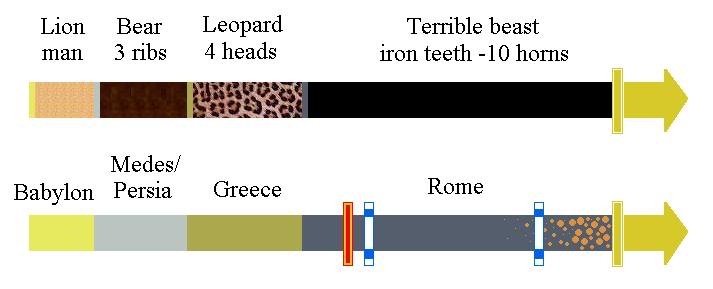
The critique offered here will show how the fit between the ancient kingdoms and the beasts is not a complete “fit” and how the Bible shows evidence that the beasts differ from the kingdoms spelled out before by Daniel chapter two. The appendix provides a new interpretation as a possible fit to the first three beasts. But apart from any new exegesis, which is why it is in the appendix, if the beasts are not the same as the kingdoms; then this section presents a parallel account, and the beasts give the reader more information about a time of interest to the end.
The history of how Daniel chapter 7 has been interpreted as being analogous on a 1:1 basis to Daniel chapter 2 is important in understanding how an error from the past can propagate to today. Scholars have long poured over Daniel’s vision of the beasts in chapter seven and compared them to the four kingdoms of Nebuchadnezzar’s statue. The linkage between the visions of Nebuchadnezzar’s statue with Daniel’s beasts includes that both were written in Aramaic: true. The book of Daniel has an overall symmetrical construction to it, and likening chapter 7 to chapter 2 is substantiated on that basis: true. Another is the coincidence that both are four in number: true. It is not surprising that commentaries and study Bibles will draw a one for one connection between the parts of the statue and the beasts. However, the comparison between the two does not fit exactly; they do not align in every aspect. Two verses given in Daniel 7 conflict with the information given in Daniel chapter 2 which invalidates a complete 1:1 equation between the two chapters.
Historically, the parts Daniel names before in chapter two are only ones scholars had to look at to assign their meaning. This comes to mind if the beasts of chapter 7 are end time nations; commentators preceding them would have nothing to look at so as to discern their true nature. The impossibility lies with their being able to predict the type of nations these beasts might be from their descriptions before these nations have developed – were they future to their examination. Only by looking back and finding characteristics for comparison can one see how the prophecy has been fulfilled.
So if these beasts were to represent end time nations, any commentary before these nations took shape and became recognizable would excuse those commentators from being able to predict the beasts of chapter seven. As they are revered, and once a die is cast it is not easily departed from by following commentators; reluctance to go against what has been long established is quite understandable. And after so much has been written, the prevailing misapplication becomes an accepted fact and the matter has been judged settled, no one looks for any other possible solution that fits better. But getting back to the fact that the comparison is invalidated within the text of Daniel chapter 7, should allow for a reexamination for the majority view of parity between the statue and the beasts.
To show the beasts from a different aspect, this section will challenge the absolute one-for-one comparison between the statue and the beasts. That comparison leads to the beasts and the statue to be only considered as multiple accounts of the same timeline.
As way of explanation for the following diagram, the top line represents Daniel 7. The vertical gold bar represents Jesus’ coming anew at the end of man’s reign; establishing the Millennium Kingdom of His Reign. The bottom timeline represents Daniel 2. The vertical gold and red bar represents Jesus’ First Advent Ministry. The first vertical blue and white bar represents Israel’s demise as a nation after the second Jewish Revolt in the second century A.D., while the second vertical blue and white bar represents the formation of the modern state of Israel post-WWII. The vertical gold bar at the end of chapter 2 is the same as it is in the first case: the Return of Jesus and the establishment of His Millennium Kingdom. This information was conveyed previously in my book, so I have inserted this paragraph here for you the reader.

The critique offered here will show how the fit between the ancient kingdoms and the beasts is not a complete “fit” and how the Bible shows evidence that the beasts differ from the kingdoms spelled out before by Daniel chapter two. The appendix provides a new interpretation as a possible fit to the first three beasts. But apart from any new exegesis, which is why it is in the appendix, if the beasts are not the same as the kingdoms; then this section presents a parallel account, and the beasts give the reader more information about a time of interest to the end.


